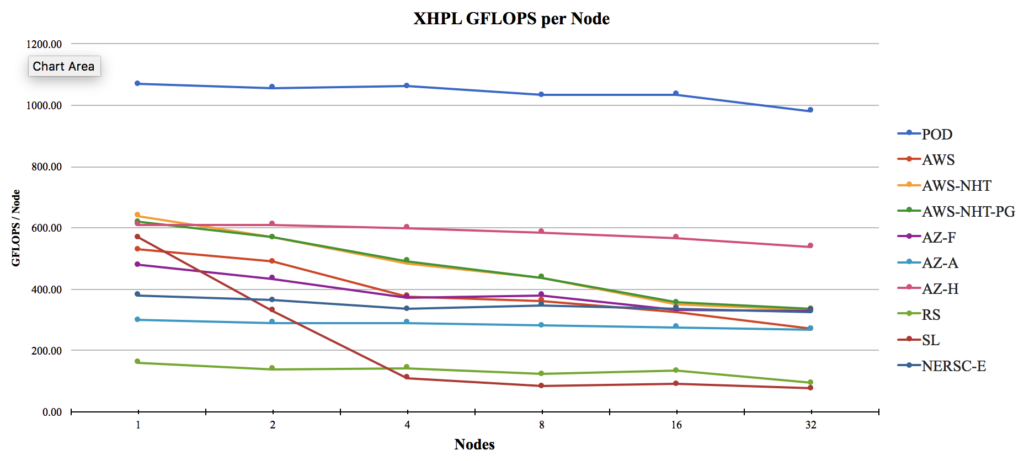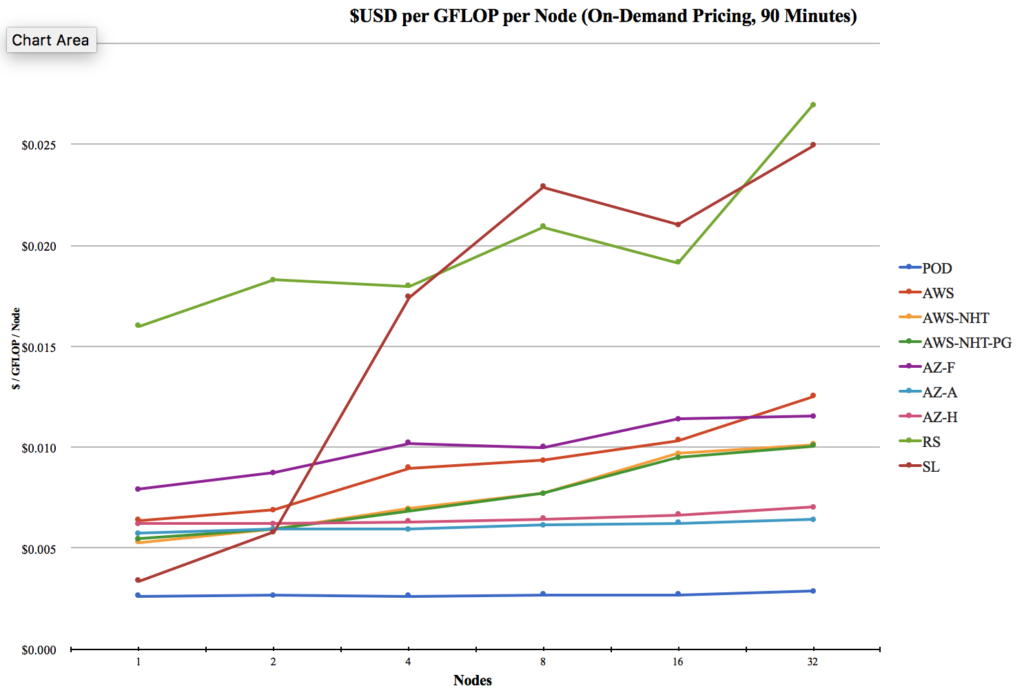Fighting for sway among the big HPC-in-the-cloud providers – AWS, Azure, etc. – is challenging for smaller players. The giants own the mindshare. HPC specialist Penguin Computing recently re-ran benchmarks from a study of its larger brethren and says the results show its ‘public cloud’ – Penguin on Demand (POD) – is among the leaders in cost and performance. The natural caveat here is Penguin ran the tests. The company says the tests accurately recreate those in the study and that it is willing to let prospects or third parties run the tests for themselves at no charge.
A marketing exercise? Of course. The Penguin effort was in response to a paper – Comparative benchmarking of cloud computing vendors with High Performance Linpack – authored by Exabyte.io and posted on arXiv.org last month. But besides simply being an effort by Penguin to gain user attention and push its way more forcefully into the land of giants such as Microsoft, Google, AWS, and IBM/SoftLayer, and Rackspace, all examined in the paper, the effort also reveals the growing competitive zeal among many providers to offer HPC in the cloud.
Where Microsoft Azure was the top performer in the original study, Penguin reports that POD comes out ahead in the new benchmarking it performed on both price and performance measures. Penguin, according to its measurements, takes the lead in terms of Linpack gigaflops-per-core, Linpack gigaflops-per-node and has it has the most favorable speedup at scale.
To some extent one would expect Penguin to outperform public cloud providers. POD is best characterized as an on-demand HPC cluster rather than a typical public cloud. It is a tightly coupled environment (with the option of OmniPath 100Gb/s interconnect, which was used for this testing). Definitional nuances aside, the bigger takeaway, if accurate, may be the POD is cheaper for HPC workloads than the major cloud players.
HPCwire covered the earlier paper (see, Azure Edges AWS in Linpack Benchmark Study). In it, performances varied with Azure besting the pack, which included a NERSC run. The primary purpose of the study was to demonstrate whether or not HPC workloads can be reliably and cost-effectively run in the cloud. Using the high performance Linpack as the performance metric and a cost comparison with traditional infrastructure, the authors’ answer is an unqualified yes.
“We benchmarked the performance of the best available computing hardware from public cloud providers with high performance Linpack. We optimized the benchmark for each computing environment and evaluated the relative performance for distributed memory calculations…Based on our findings we suggest that the concept of high performance computing in the cloud is ready for a widespread adoption and can provide a viable and cost-efficient alternative to capital-intensive on-premises hardware deployments,” write the authors, Mohammad Mohammadi, Timur Bazhirov of Exabyte.io.
Penguin, of course, is well known for its HPC expertise and Tundra servers. In November the company had seven systems on the Top500. Not surprisingly, the POD offering is HPC-centric. “We recognize the need for high performance nodes with modern processors, bare metal, non-blocking fabric, the kind of infrastructure you would design if you were building a large scale HPC cluster in house,” says Victor Gregorio, Sr. VP of Cloud Services.
POD provides two locations for cloud computing that can be accessed through a single POD Portal, MT1 and MT2. Each location has localized storage, and high-speed interconnects between the sites to facilitate easy migration of data from one location to another.
Login nodes and storage volumes (user home directories) are local to each location, but usernames are global to all of POD’s locations. The POD Portal’s usage reports are global to all POD locations.
The tests were run at the MT2 datacenter on POD’s B30 nodes, which feature Intel Broadwell E5-2680 v4 processors (2.4Ghz, 14 cores, 16 double precision Flops/cycle) and deliver 1.07 Tflops peak per node. The MT2 location uses Intel OmniPath interconnect. The other clouds in the study do not have the current highest-end networking, although the Azure nodes (AZ-A and AZ-H) and NERSC Edison do employ high-speed interconnects (40Gbs InfiniBand and Cray Aries respectively) — details of the various node architectures/processors are best gleaned from the Exabyte.io paper.
As shown in the table and figures below, Penguin argues POD performs on par with the best of the big providers and that its costs are less, at least as evaluated in the study.
By this comparison, POD consistently performed at or near the top with performance scaling well with increased node/core count. The cost comparison is even more disparate, despite POD having a significantly higher initial rate per node, $2.80 per node hour versus the highest cost of the majors, $1.90/node/hour for the Azure IB-A node. Buyer beware: Penguin compared publicly disclosed rates and did not factor in potential discounts.


The cost reduction drivers, according to Penguin, include higher performance, reduced wall clock time, fine grain metering down to roughly three seconds versus rounding up to the nearest hour used, and the lack of many common additional charges such as data transfer, bandwidth, set-up, etc.
“You are not billed for idle time, you are only billed for compute time. But the biggest thing is the other cloud vendors will round up to the hour,” he says. A job that ran 90 minutes would cost the same as one that ran 61 minutes or 62 minutes in billing schemes that round up. Most jobs, he notes, are not nicely divisible by hours. Penguin meters down to roughly three seconds of use. “When you look at what I feel is a real-world situation we are clearly more cost-effective than other providers for HPC workloads,” Gregorio says.
Currently, there are five different queues on POD, each pointing to a cluster with different resources and capabilities. Lower performing environments are lower cost. That said, all of them have been designed for HPC workloads according to Gregorio.
Penguin doesn’t say much about the size of the POD customer base. Sid Mair, SVP, Federal Systems, emphasized POD is the fastest growing part of the company and that its customers are not drawn only from existing Penguin customers for on-premises equipment and services. One POD customer is running multi-thousand core jobs, he says while there’s a university with on the order of 300 students submitting “tiny” jobs daily. Weather forecasting, automotive, and traditional engineering disciplines are all represented. Gregorio considers a 4,000-core job to be a big one.
“Almost every HPC application on the market place runs on POD and many of them are already loaded in the environment we use. We have many relationships where customers transfer their corporate licenses right into POD rather than have to worry about managing them,” says Gregorio, adding the list of applications on the web-site slightly lags their ongoing efforts add more applications and tools. Most of the familiar names are already there such as ANSYS, Dassult Systems, and MathWorks.
Perhaps surprisingly, the GPU node offering (NVIDIA K40) is modest when compared to recent aggressive adoption of K80 and P100 devices by the major cloud players. Gregorio says Penguin is demand-driven and able to scale as the need arises.
“As we see demand in the market place for things like deep learning, we’ll adopt it. We are currently working with a number of customers for on-premises deep learning/machine learning environments and we’re using that experience to understand the needs for optimal HPC environment in the cloud. We aren’t ready to publicly disclose our plans yet,” says Gregorio.































































